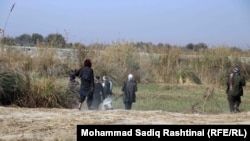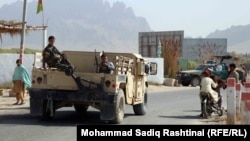KANDAHAR, Afghanistan -- An offensive by Afghanistan’s Taliban militants appears to be aimed at reclaiming Afghanistan’s second city, which once served as the capital for the hard-line movement nearly a quarter-century ago.
Hundreds of insurgents, civilians, and soldiers have reportedly been killed and thousands of villagers have so far been displaced during nearly 10 days of fighting around the city of Kandahar, capital of a key province by the same name. In a concerted move, large numbers of Taliban fighters forced outnumbered Afghan troops to retreat from parts of serval rural districts.
The offensive follows failed Taliban attempts to overrun two strategic provincial capitals last month. It also showcases that instead of negotiating peace with the Afghan government in a stalled peace process, the Taliban is fighting for a commanding military advantage as the date for a complete U.S. withdrawal nears early next year.
“Unfortunately, contrary to all human rights conventions, the Taliban is holding civilians hostage to protect itself from our air strikes and artillery fire,” Hayatullah Hayat, Kandahar’s governor, told Radio Free Afghanistan. “We want to protect our people.”
The Taliban, however, has rejected the Afghan government’s claims and accused Kabul of targeting civilians in air strikes.
Hayat says the Taliban surprised them by suddenly infiltrating government-controlled territories last week but maintained that the city is secure. “I can assure you that we have established a secure parameter around Kandahar city, and it is well protected,” he said.
The rural area Hayat alluded to were five villages in Arghandab, an agricultural district northwest of Kandahar. Nisar Ahmad, a farmer in Arghandab’s Nagahan village, recalls being awakened by Taliban fighters in his pomegranate orchard last week.
“They told us to immediately run to our houses because they wanted to plant mines and dig trenches in our orchards to target the Afghan forces,” he told Radio Free Afghanistan. “Apart from one narrow alley, all streets in our village are now mined.”
Once establishing their positions in Arghandab, the Taliban extended its offensive to the adjoining districts of Zharay, Maiwand and Panjwai. The three districts are located along a major road connecting Kandahar to Lashkar Gah, the capital of neighboring Helmand Province, which the Taliban attempted to overrun last month.
To showcase their advances, the Taliban has flooded social media with videos and photographs showing captured Afghan military outposts and ammunitions. One striking video shows Afghan Army Humvees and trucks speeding past armed Taliban fighters in Arghandab.
“If they [the government forces] don’t insist on fighting, we are amenable to a deal and willingly let them pass and surrender peacefully,” Zabihullah Mujahid, a purported Taliban spokesman, told OrbandNews, an Afghan website.
The fighting, however, is extracting a heavy toll on civilians.
Casualties are piling up at Kandahar’s Mirwais Hospital. “I was fleeing fighting with my family when I stepped on a mine and then regained copiousness in this hospital,” Abdul Bari, a young farmer from Nagahan, told Radio Free Afghanistan.
Qudratullah Hakimi, a surgeon at the same hospital, confirmed that civilians made up the vast majority of the 25 killed and 222 injured in the fighting around Kandahar. “More than 141 of these had gunshot wounds while 67 were injured by mines,” he told Radio Free Afghanistan on October 4. “Another 14 were wounded in air strikes,” he added.
Jamal Nasir Barakzai, a spokesman for Kandahar’s police chief, claimed that more than 400 Taliban fighters have been killed and wounded in the government’s counterattacks on the insurgents. “More than 300 were killed while the rest were gravely injured,” he told Radio Free Afghanistan.
Mujahid, the Taliban spokesman, however, acknowledged that only a handful of their fighters were killed and wounded because most of the government air strikes were blind or inaccurate.
Afghan civilians, however, are paying a high price. Hameed Gul Kaka, a farmer from Arghandab, and his relatives are among some 2,000 families displaced by the fighting around Kandahar. He told Radio Free Afghanistan that they fled with just the clothes on their backs.
“We have received some flour. I am now trying to somehow make bread and distribute it to the children so they don’t die of hunger,” he told Radio Free Afghanistan in Dhand, a district neighboring Arghandab. Most of the farmers fleeing Arghandab were unable to harvest their pomegranate orchards, their main source of income.
Abdul Habib, another displaced from Arghandab, says tens of thousands are likely to join their ranks soon. “It is a war-like situation that will likely force many to run away from their homes,” he said.
Dost Mohammad Nayab, provincial head of the Afghan Refugee Repatriation Ministry, says they are trying to help those displaced by the fighting. He estimates some 10,000 families will be displaced within the next month in Kandahar and neighboring provinces. “If the security threats continue to mount, we are likely to see more displacement,” he said.
Kandahar, a former seat of Afghan empires in the 18th century, holds a pivotal political significance in Afghanistan. In 1994, the Taliban emerged from districts surrounding this ancient city and it remained their capital and the seat of their founder, Mullah Omar.
Reclaiming Kandahar had been a top Taliban military objective following the demise of their hard-line regime in late 2001.
Abubakas Siddique wrote this story based on Mohammad Sadiq Rashtinai’s reporting from Kandahar, Afghanistan.














